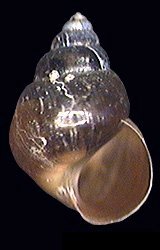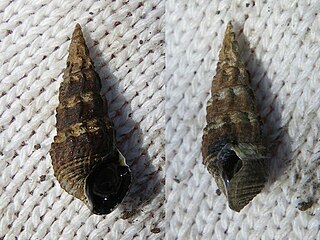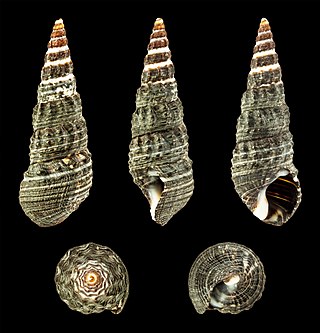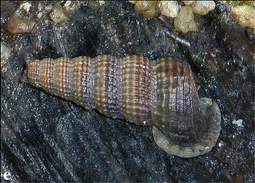
Isopoda is an order of crustaceans that includes woodlice and their relatives. Isopods live in the sea, in fresh water, or on land. All have rigid, segmented exoskeletons, two pairs of antennae, seven pairs of jointed limbs on the thorax, and five pairs of branching appendages on the abdomen that are used in respiration. Females brood their young in a pouch under their thorax.

Jean Guillaume Bruguière was a French physician, zoologist and diplomat.

Zeacumantus is a genus of small to medium-sized sea snails or mud snails, marine gastropod mollusks in the family Batillariidae.

Zeacumantus subcarinatus, common name the southern creeper, is a species of small sea snail or mud snail, a marine gastropod mollusc in the family Batillariidae.

Assiminea is a genus of minute, salt-tolerant snails with an operculum, aquatic gastropod mollusks, or micromollusks, in the family Assimineidae.
Batillaria mutata is a species of small mudflat saltwater snail, a marine gastropod mollusk in the family Batillariidae, the horn snails.

Batillaria is a genus of small salt marsh or mudflat snails, marine gastropod mollusks in the family Batillariidae, the horn snails.

Pseudofeces or pseudofaeces are a specialized method of expulsion that filter-feeding bivalve mollusks use in order to get rid of suspended particles such as particles of grit which cannot be used as food, and which have been rejected by the animal. The rejected particles are wrapped in mucus, and are then expelled without having passed through the digestive tract. Thus, although they may closely resemble the mollusk's real feces, they are not actually feces, hence the name pseudofeces, meaning false feces.
The World Register of Marine Species (WoRMS) is a taxonomic database that aims to provide an authoritative and comprehensive list of names of marine organisms.
William Henry Benson was a civil servant in British India and an amateur malacologist. He made large collections of molluscs and described numerous species from the U.K., India and South Africa.

Batillariidae, common name batillariids or mudcreepers, are a family of marine, cerithioidean gastropod molluscs in thesuperfamily Cerithioidea.

Batillaria zonalis is a species of small sandy shore snail, a marine gastropod mollusk in the family Batillariidae, the horn snails.

Cerithidea is a genus of medium-sized sea snails or mud snails, marine gastropod mollusks in the family Potamididae, the horn snails.

Batillaria attramentaria, common name the Japanese mud snail, is a marine gastropod mollusk in the family Batillariidae. It is a species of sea snail most often found in the salt marshes and mudflats of marine, estuarine, riparian and wetland habitats. Introduced to North America between the 1920s to 1930s via the coasts of Washington and California, the Japanese mud snail became an invasive species notorious for reducing biodiversity by outcompeting the native hornsnail Cerithidea californica.

Batillaria australis is a species of sea snail, a marine gastropod mollusk in the family Batillariidae.
Batillaria flectosiphonata is a species of sea snail, a marine gastropod mollusk in the family Batillariidae.

Batillaria multiformis is a species of sea snail, a marine gastropod mollusk in the family Batillariidae.
Batillaria sordida is a species of sea snail, a marine gastropod mollusk in the family Batillariidae.

Cerithium caeruleum, the Cerith sand snail, is a species of sea snail, a marine gastropod mollusk in the family Cerithiidae. Cerithium caeruleum, also be called Cerithium caeruleum G.B. Sowerby II, 1855 generally can be found in large populations on intertidal rocky shores and are covered by a thin layer of sediments. They have large and solid shells, and their radula ribbon robust long about one-fifth the shell length. This species lives in the planktonic stage from 90 to 120 days and has a seven-year life history. This common intertidal species is confined to east Africa, Madagascar, and the Arabian Peninsula and is unlikely to be confused with any other Cerithium species. It is distinguished by its squat, knobby shape; and as indicated by its name, caeruleum, a grayish blue color with spiral rows of black tubercles.

Cerithideopsis californica, common name the California hornsnail or the California horn snail, is a species of sea snail, a marine gastropod mollusk in the family Potamididae. This series was previously known as Cerithidea californica.














